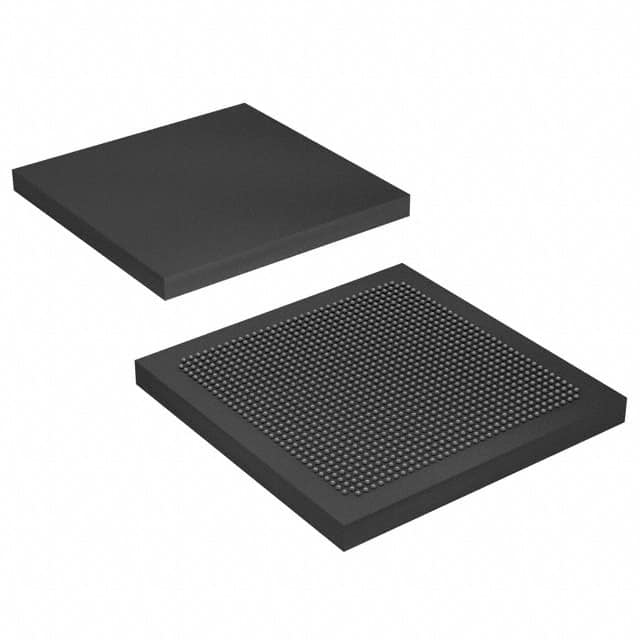EP4SE360F35I4N
Product Overview
- Category: Field Programmable Gate Array (FPGA)
- Use: EP4SE360F35I4N is a high-performance FPGA designed for various applications in the fields of telecommunications, automotive, industrial automation, and more.
- Characteristics: This FPGA offers advanced features such as high-speed processing, low power consumption, and reconfigurability. It provides a flexible platform for implementing complex digital systems.
- Package: EP4SE360F35I4N comes in a compact package that ensures easy integration into different electronic devices.
- Essence: The essence of this product lies in its ability to provide customizable digital logic circuits, enabling designers to create tailored solutions for specific applications.
- Packaging/Quantity: Each EP4SE360F35I4N unit is packaged individually and is available in various quantities to meet different project requirements.
Specifications
- Logic Elements: EP4SE360F35I4N consists of 360,000 logic elements, allowing for the implementation of complex digital designs.
- Memory: It offers up to 8,100 Kbits of embedded memory, providing ample storage for data processing.
- Clock Management: The FPGA includes advanced clock management circuitry, supporting multiple clock domains and ensuring precise timing control.
- I/O Interfaces: EP4SE360F35I4N features a wide range of I/O interfaces, including LVDS, DDR3, PCIe, and Ethernet, facilitating seamless connectivity with external devices.
- Operating Voltage: The FPGA operates at a voltage range of 1.2V to 3.3V, offering flexibility in power supply requirements.
- Package Type: EP4SE360F35I4N is available in a fine-pitch ball grid array (FBGA) package, which enhances thermal performance and simplifies PCB layout.
Pin Configuration
For detailed pin configuration information, please refer to the EP4SE360F35I4N datasheet or user manual provided by the manufacturer.
Functional Features
- High-Speed Processing: EP4SE360F35I4N offers high-speed processing capabilities, enabling rapid execution of complex algorithms and data manipulation.
- Reconfigurability: The FPGA can be reprogrammed multiple times, allowing for flexibility in adapting to changing system requirements.
- Low Power Consumption: EP4SE360F35I4N is designed with power-efficient circuitry, minimizing energy consumption without compromising performance.
- Versatile I/O Interfaces: The FPGA supports a wide range of I/O standards, facilitating seamless integration with various external devices.
- Advanced Clock Management: It includes advanced clock management features, ensuring precise timing control and synchronization.
Advantages and Disadvantages
Advantages: - High-performance processing capabilities - Reconfigurable nature allows for adaptability - Low power consumption for energy efficiency - Versatile I/O interfaces for seamless connectivity - Advanced clock management for precise timing control
Disadvantages: - Steep learning curve for beginners due to complexity - Higher cost compared to traditional fixed-function integrated circuits - Requires specialized design tools and expertise for efficient utilization
Working Principles
EP4SE360F35I4N operates based on the principles of field programmable gate arrays. It consists of an array of configurable logic elements interconnected through programmable routing resources. These logic elements can be programmed to implement desired digital functions, creating custom digital circuits. The FPGA's functionality is determined by the configuration data loaded into its internal memory.
Application Field Plans
EP4SE360F35I4N finds applications in various fields, including: - Telecommunications: Used in network infrastructure equipment, such as routers and switches, for high-speed data processing and protocol handling. - Automotive: Employed in automotive electronics for functions like advanced driver-assistance systems (ADAS) and infotainment systems. - Industrial Automation: Utilized in industrial control systems for real-time monitoring, process control, and automation tasks. - Aerospace: Applied in aerospace systems for avionics, radar signal processing, and communication systems.
Alternative Models
- EP4SE260F29I3N: A similar FPGA with a lower logic element count but suitable for less complex applications.
- EP4SE530H40C2N: A higher-end FPGA with increased logic elements and enhanced performance capabilities.
- EP4SE820F43I4N: An FPGA offering a larger embedded memory capacity, ideal for data-intensive applications.
Please note that the above alternative models are suggestions and may not cover all possible alternatives. It is recommended to consult the manufacturer's product portfolio for a comprehensive list of available options.
Word Count: 536
Lista 10 Vanliga frågor och svar relaterade till tillämpningen av EP4SE360F35I4N i tekniska lösningar
Sure! Here are 10 common questions and answers related to the application of EP4SE360F35I4N in technical solutions:
Q: What is EP4SE360F35I4N? A: EP4SE360F35I4N is a specific model of Field-Programmable Gate Array (FPGA) manufactured by Intel.
Q: What are the key features of EP4SE360F35I4N? A: Some key features include high-performance logic fabric, embedded memory blocks, DSP blocks, and various I/O interfaces.
Q: What are the typical applications of EP4SE360F35I4N? A: EP4SE360F35I4N is commonly used in applications such as telecommunications, networking, industrial automation, and high-performance computing.
Q: How does EP4SE360F35I4N differ from other FPGA models? A: EP4SE360F35I4N offers a specific combination of logic capacity, performance, and I/O capabilities that make it suitable for certain applications.
Q: Can EP4SE360F35I4N be reprogrammed after deployment? A: Yes, EP4SE360F35I4N is a field-programmable device, meaning its configuration can be modified even after it has been deployed in a system.
Q: What development tools are available for programming EP4SE360F35I4N? A: Intel provides Quartus Prime software suite, which includes tools for designing, simulating, and programming EP4SE360F35I4N.
Q: Are there any specific design considerations for using EP4SE360F35I4N? A: Yes, designers need to consider factors like power consumption, thermal management, and signal integrity when using EP4SE360F35I4N in their designs.
Q: Can EP4SE360F35I4N interface with other components or devices? A: Yes, EP4SE360F35I4N supports various I/O standards and interfaces, allowing it to communicate with other components or devices in a system.
Q: Are there any limitations or constraints of EP4SE360F35I4N? A: EP4SE360F35I4N has specific resource limitations such as logic elements, memory blocks, and DSP blocks, which need to be considered during design.
Q: Where can I find more information about EP4SE360F35I4N? A: You can refer to the official documentation provided by Intel, including datasheets, user guides, and application notes, for detailed information about EP4SE360F35I4N.
Please note that the answers provided here are general and may vary depending on the specific requirements and context of the technical solution.


